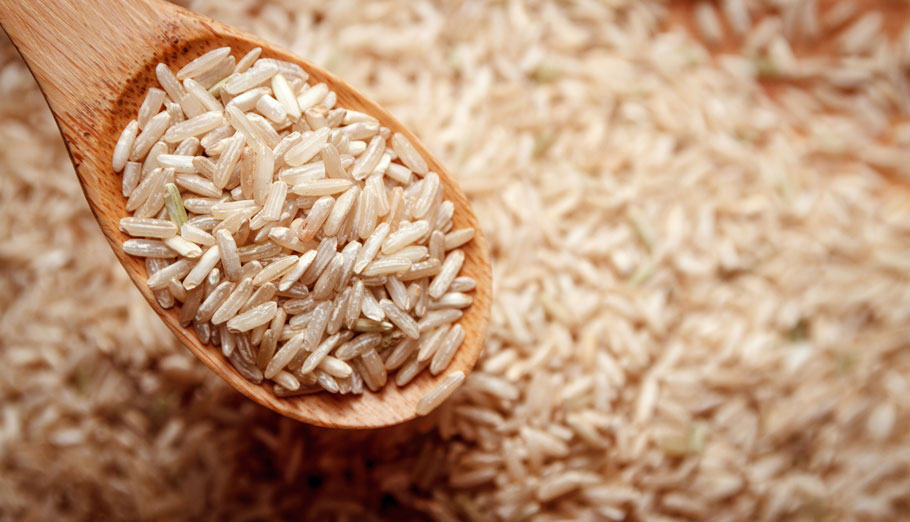Brown Rice

Overview (Gluten Free)
Brown rice flour is often preferred over white rice flour for the same reason brown rice is preferred over white rice: A high selenium and manganese content, more fiber, and antioxidant content. The process of refining rice into shiny white grain strips out the hull and bran, which is where most of the fiber and nutrients in rice are. No artificial “enrichment” is needed with brown rice flour.
Brown rice flour is well suited for breads, noodles, cakes, and for thickening sauces or used as a coating on fried foods. It is high in fiber, protein, iron and vitamin B, and tends to give baked goods a darker color as well as a nuttier flavor than whole wheat flour.
Nutrition
With brown rice, only the hull of the kernel is removed—resulting in minimal loss of its nutritional value. White rice is produced by milling and polishing brown rice, a process which destroys 90% of its vitamin B6 content, 80% of its vitamin B1, 67% of its vitamin B3, 60% of its iron, 50% of its manganese and phosphorus, and all the dietary fiber and essential fatty acids within the kernel. White rice is “enriched” after all this processing, but adding synthetic vitamins cannot compare with the value of these nutrients present in their natural form in brown rice.
Note: Weight of a cup (or partial cup) of flour varies depending upon whether it is lightly sprinkled into a measuring cup or compacted. Most recipe measurements are based on sifted flour as a way to arrive at more uniform measurement.
Gluten Content & Allergen Information
Brown rice is one of many gluten-free grains, which make brown rice flour an excellent choice for anyone with gluten intolerance or Celiac disease. However, many individuals have rice allergies. Their allergic reactions can be so severe as to cause asphyxiation by swelling of the tongue and throat.
Be sure to purchase grains specifically marked as gluten-free. Although brown rice flour is inherently gluten-free, it may become contaminated with wheat during processing.
Nutrition Facts
| Serving Size | 1 Cup |
| Calories | 679 |
| Total Fat 6g | 8% |
| Cholesterol 0mg | 0% |
| Sodium 9mg | 1% |
| Carbohydrates 141g | 47% |
| Dietary Fiber 7g | 24% |
| Total Sugars 1g |
| Protein 14g |
| Vitamin D 0mcg | 0% |
| Calcium 17mg | 2% |
| Iron 2mg | 12% |
| Potassium 0mg | 0% |
* The % Daily Value (DV) tells you how much a nutrient in a serving of food contributes to a daily diet. 2,000 calories a day is used for general nutrition advice.
Diet Compatibility
Paleo Diet
The Paleo Diet seeks to emulate the hunter-gatherer diet of our stone-age ancestors. The emphasis is on wild plants and meats similar to what ancient man would have consumed. As such, dairy products, refined sugar, and processed oils are off limits. While many Paleo Diet followers also avoid grains, there is ample archaeological evidence to show that grains were part of Paleolithic era man’s diet.
Compatibility with Brown Rice Flour:
Not Compatible

Mediterranean Diet
This diet seeks to emulate the diets of those living along the Mediterranean coast, with an emphasis on fresh fruits and vegetables, seafood/fish at least twice a week, limited servings of poultry, and only occasional sweets and red meat.
Compatibility with Brown Rice Flour:
Compatible

Gluten-Free Diet
As the name suggests, the gluten-free diet eliminates all foods with gluten. Although most of those on a gluten-free diet are on it out of necessity—either due to severe wheat allergies or Celiac disease—many have embraced a gluten-free diet as being healthier.
Compatibility with Brown Rice Flour:
Compatible

Macrobiotic Diet
Although there are many versions of macrobiotic diets, the common thread is that they emphasize natural, whole foods, grown locally and organically. Whole grains, vegetables, legumes, fruits, seeds and nuts, and occasional seafood are all integral to the diet. Red meats, dairy, poultry, eggs, and processed foods are off the menu.
Compatibility with Brown Rice Flour:
Compatible

Acid Alkaline Diet
This diet aims to restore the slightly alkaline state of the body, which is believed to be ideal. By focusing on a diet high in vegetables, fruits, sprouted grains, lentils, almonds and soy products, the goal is to have a balance of 80% alkalizing foods and 20% acid forming foods.
Compatibility with Brown Rice Flour:
Compatible – Brown Rice Flour is condiered to be of neutral acidity

Low-Carb Diet
As the name suggests, this diet focuses on reducing carbohydrates in the diet to lose weight. The theory is that by staying away from high-carb foods like pasta and bread and eating low carb, high fiber vegetables and fruits instead, your body will go into ketosis and you will lose weight. This diet is sometimes referred to as a ketogenic diet.
Compatibility with Brown Rice Flour:
Compatible

Atkins Diet
The Atkins Diet is a historically popular low-carb diet, instructing dieters not to worry about their calories but to monitor and minimize their intake of sugar and carbohydrates. According to Dr. Atkins, depriving the body of its primary energy sources causes the body to burn fat.
Compatibility with Brown Rice Flour:
Compatible

“We love the mill! We use it every day for things from bread, to pastry and it is phenomenal. The biggest selling point for me was the fineness since that would mean we can really do some great pastry with it in addition to bread. It definitely has been great!"
BEN FROM NORTH CAROLINA

